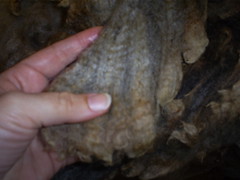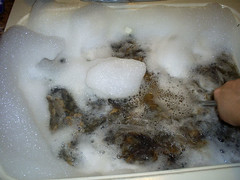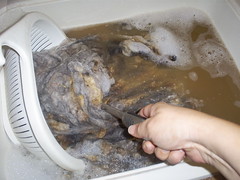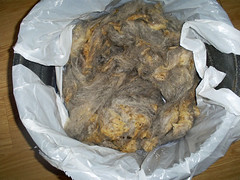I came across a post the other day from Doowicky, another wool-lover like me. She had some new ideas for scouring fleece, which, in itself, is usually kind of a pain in the butt to do. We all fall in love with the sticky, greasy mass of fiber in those clear plastic bags at fiber shows. But once we get those bags home, our work areas start to smell like BARNS. Time to clean the gunk out of those fleeces!
I got this gorgeous fleece from the Michigan Fiber Fest, and it was the first-place winner for colored wool. It was 6.2 pounds of wonderful-ness, from a sheep named "Lambchop", raised byAnnette Johnston of Ira, MI. Lambchop is 3/8 Rambouillet, 1/4 Suffolk, 1/4Lincoln, and 1/8 Romney. That's quite a mix! But what a fantastic fleece! The most beautiful I've ever had thus far. This sheep is amazing. He's over NINE years old, and still is producing a prize-winning fleece:

Lambchop is a mostly-grey fleece with beautiful locks. You could literally lay it out like a blanket, all lock structure intact.

So, I washed the second batch of the fleece using Doowicky's method. I thought I'd lay out the process here. First, into the sink full of hot water and detergent. My water heater is set for 130 degrees, so that gives you an idea of what temperature to shoot for. I use a lavender-scented soap with no dyes, and I use about the same as I would use for a load of dirty clothes.

I gently pushed the fleece down into the hot water, and I didn't get too far with my hand. I used my trusty big spoon, and I very gently worked it down into the soap and water until it was completely submerged. I left it there for about half an hour, and used my spoon to carefully poke around a tiny bit to loosen dirt (NO swishing, swirling or agitation!):

This first wash water was DIRTY, as you can well imagine. It's absolute poop-water. There's no other way to describe it. Next up, I gently scooped up the fiber en masse (and this is important...do NOT separate the fibers here!) into the colander, and let the poop-water drain away.

Next, I pressed out the water, and I left it in the colander to do this. Doowicky says to place the fiber on the floor of the sink and press using a cutting board. I just used my hand or my big spoon to press. Notice I did not say "squeeze"...NO SQUEEZE! Just PRESS!

Into the rinse the fiber goes. Do NOT let water run directly on fiber. Either remove it from the sink completely, or keep it away from running water:
 Just let the fiber sit in the rinse water...I poke at mine a little bit with the spoon to help loosen things up a bit. But no agitation.
Just let the fiber sit in the rinse water...I poke at mine a little bit with the spoon to help loosen things up a bit. But no agitation.
You'll want to rinse the wool at least one more time, more likely two, the same way. If the wool is really dirty, repeat both the wash (with soap) and rinses. Once this is done, here's the most important part: take the fiber en masse once again, and put it into a bucket or dishpan and let it cool completely. Do not play with the fiber or tease it in any way. Just let it cool, all the way. Here's my first batch of fiber, sitting in the bucket to cool:

Yes, I know...it's a thing of pure beauty, right? : ) Anyway, just keep washing your fleece and adding it to the bucket to cool. Once it is COMPLETELY cool, you will spin it out in the washer. Make sure your washer does NOTHING but spin on it's spin cycle! Some washers will blow more water on your precious fleece, while spinning. You do NOT want that (unless you want to risk felting). ONLY spin:

After it has spun, carefully remove from the washer and lay it out somehow to dry for a couple days. Gently spread it out; while it's wet, you don't want to be teasing and pulling apart locks. Save that business for carding. Best way to dry the wool is elevated on a screen, but since I don't have that, I lay mine out on a sheet on the floor. then I try hard to keep the cat out of it (sigh...the cat was NOT my idea). The lock structure is almost totally intact, and just a tiny bit of matting on the cut edges. Now that it's completely dry, I am impressed at how easily the fibers drift apart when I tease them. Carding is going to be a breeze:

Lovely and gorgeous, yes? Well, beauty is in the eye of the beholder, they say. Here is what my daughter thinks about all this dirty-fleece-business (her expression caught right after taking a look at the first wash-water in the sink):

Oh child, if you only could understand!
Happy fleece-washing! I'll be following up with dyeing, carding, and color-blending of this very special, beautiful fleece for a very special, amazing project for an amazing man......!


Julie, on my blog you asked a question and I didn't see it until now, so am answering it here also so that you'll get a "comment email."
ReplyDeleteI only leave a fleece in the hot wash water 10 minutes. My own goal at that point is loosening and breaking down dirt, but mostly melting the lanolin, so I figure too long in the wash water could let the water cool down, risking the redepositing of lanolin back onto the fiber. I don't know at what temp that would start to happen, but it sounds like you had happy results, so if it doesn't feel sticky at all, I wouldn't worry about it. I did have one bag that, after some months, felt sticky so either I didn't leave it in long enough or too long. The rest of it I've always only left it in 10 minutes, and haven't felt any stickiness. ;-)
OHG that pic is so great! I have 4 kids that make that face every time I wash a fleece LOL
ReplyDeleteSo even if you have a lot of vm you wait to the carding step? to remove it? And does this work better then picking it out before?